To celebrate International Women’s Day, we’d like you to meet the women who kicked some serious science butt during Investigator’s 51 day Antarctic voyage.
To celebrate International Women’s Day, we’d like you to meet some incredible women in science who are breaking the seafarer mould. They’ve just returned from Investigator’s recent 51 day Antarctic voyage, where they kicked some science butt! Although they have different backgrounds, these women came together to try to understand what Antarctica was like in the ancient past, to try to predict its future.
Associate Professor Leanne Armand, Macquarie University
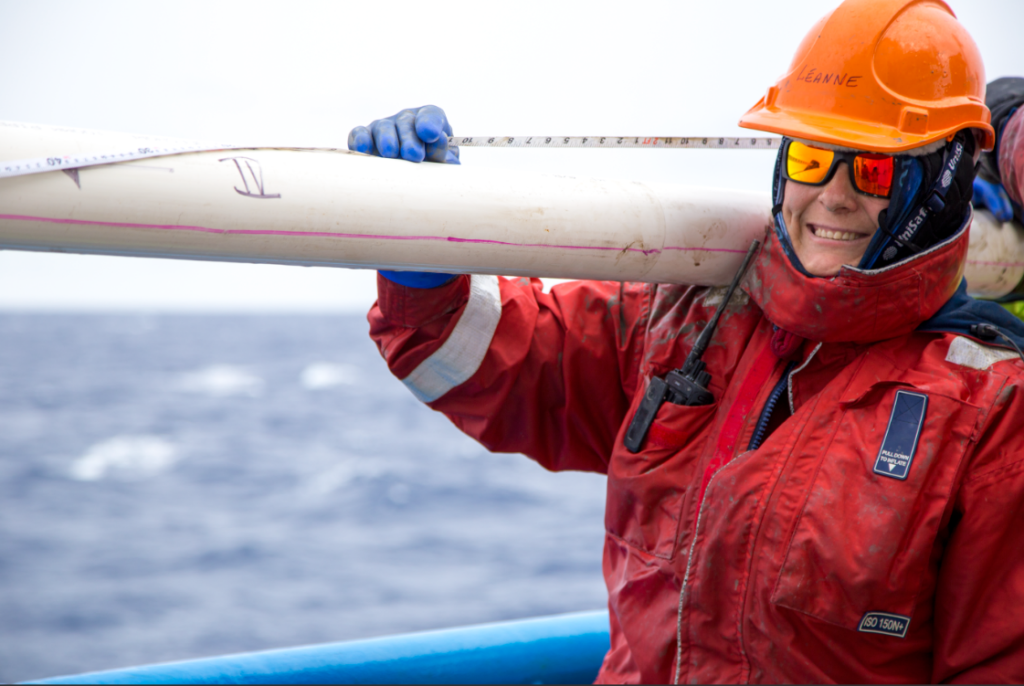
Leanne with a piston core sample, which she is collecting to understand what Antarctica was like hundreds of thousands of years ago
Leanne with a piston core sample, which she is collecting to understand what Antarctica was like hundreds of thousands of years ago.
When Leanne stepped onto her first major research vessel more than 22 years ago, she was one of eight women on board a ship with 60 men. Women had to sit at the Captain’s table for dinner and wear either a dress or long skirt.
Fast-forward a few years and more than ten scientific voyages, to today and Leanne has just dusted off her work boots after being Chief Scientist on Investigator’s recent voyage to the Sabrina Coast in East Antarctica.
“I never thought I would ever get the opportunity to be Chief Scientist on an Australian vessel because until Investigator was built, we just didn’t have the capability to deploy the types of equipment required for my research. It’s definitely been a career highlight,” said Leanne.
Leanne’s work focuses on diatoms, a type of microscopic photosynthetic marine algae.
“These tiny microscopic organisms help sustain the ocean ecosystem but also the planet. If they were all to die, there wouldn’t be enough oxygen for us to breathe, and because they are the base of the ocean food-web, everything in the ocean wouldn’t have food to sustain it,” said Leanne.
“They also tell us important information about the world’s past and current climate. I feel that by studying them, I’m providing a piece of the climate puzzle but also improving our understanding of the ecosystem of life on Earth.”
Dr Taryn Noble, University of Tasmania
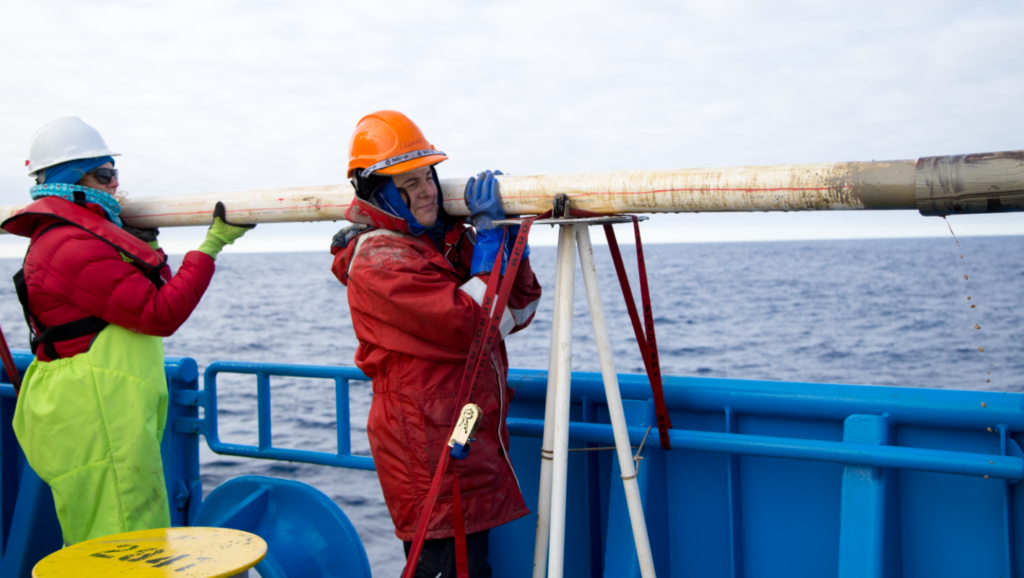
Taryn and Leanne dismantling the piston corer on board Investigator
Taryn (L) and Leanne (R) dismantling the piston corer on board Investigator.
Taryn is ridiculously smart; so smart she was one of only a handful of students selected each year to complete a PhD at the University of Cambridge in England.
Drawn to the secrets of the ocean, Taryn’s work has mostly focused on the important role oceans play in the world’s climate, both now and in the past.
“Understanding processes in the ocean helps us understand the global climate system better,” said Taryn.
In the pursuit of science, Taryn had to leave her two-year-old son and husband to sail to the bottom of the world.
“As a mother and a budding scientist at the same time, it’s extremely hard to leave your child for almost two months, but I am really lucky to have such a supportive partner, and grateful to be able learn what it takes to pull off such a successful expedition from Leanne.
“With as much as 3.5 metres of potential sea level rise from this part of East Antarctica alone, it’s important we gather as much information as possible.”
Taryn’s research on Investigator is helping to understand recent reports of ocean-driven warming underneath the rapidly melting Totten Glacier and identify if this has ever happened in Antarctica’s past, or if this is a significant first time event.
Dr Alix Post, Geoscience Australia
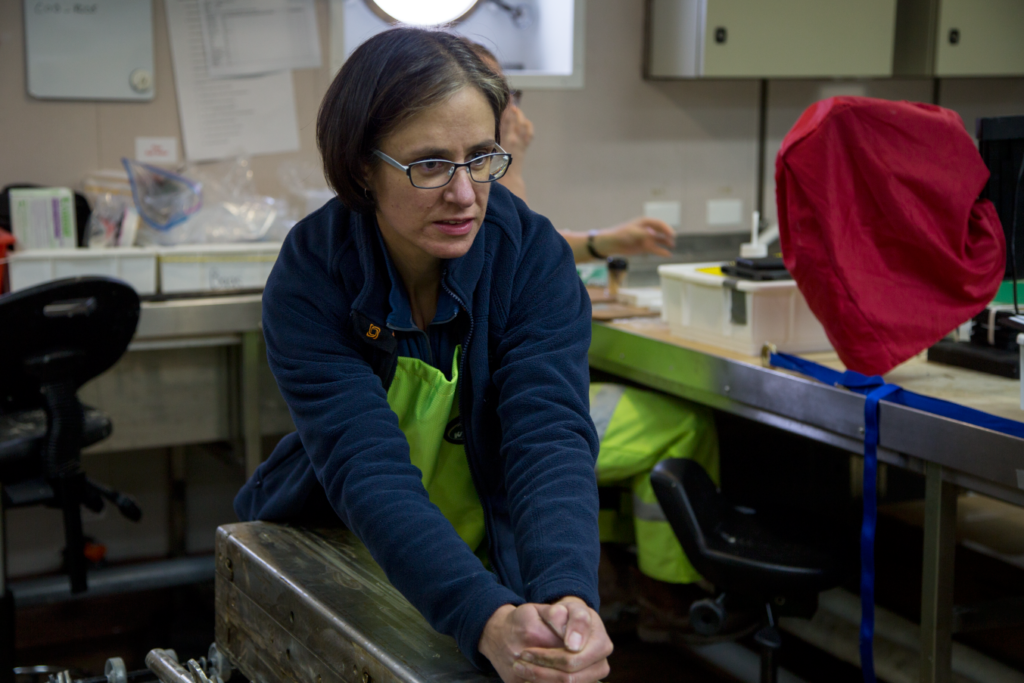
Alix dismantling a Kasten corer, which takes up to four metre samples of the sea floor
Alix dismantling a Kasten corer, which takes up to four metre samples of the sea floor.
Alix Post is a geologist with an interest in life beneath the sea. She’s worked as a marine geoscientist for more than 13 years and has been part of voyages from the tropics to the South Pole.
“Geology is a speciality that has mostly been male dominated but over the last few years there have been more and more female scientists drawn to the field,” said Alix.
The recent voyage on Investigator was Alix’s eighth research voyage and in the last ten years, she has spent around nine months at sea.
“My first voyage to Antarctica was really exciting, but this trip on Investigator has been a real highlight. It’s such a fun and enthusiastic team to work with, everyone is really committed to collaborating together, to understand the science,” Alix said.
“Luckily, I have a really supportive husband who looks after our two children while I’m away at sea.”
Alix said that going to sea was always a highlight because you never knew what you might find.
“It’s so exciting to see the science progressively unfold. I like to think that I’m an underwater detective – looking at where different animals live on the seafloor, and then using all the other datasets that we collect to understand why different animals live where they do.
“Several years ago I was involved in work near the Mertz Glacier in Antarctica where we found masses of brightly coloured hydro-corals along the sea floor. It was so unexpected because hydro-corals are quite fragile and we were surprised to see them living in such a harsh environment.”
Professor Amy Leventer, Colgate University, USA
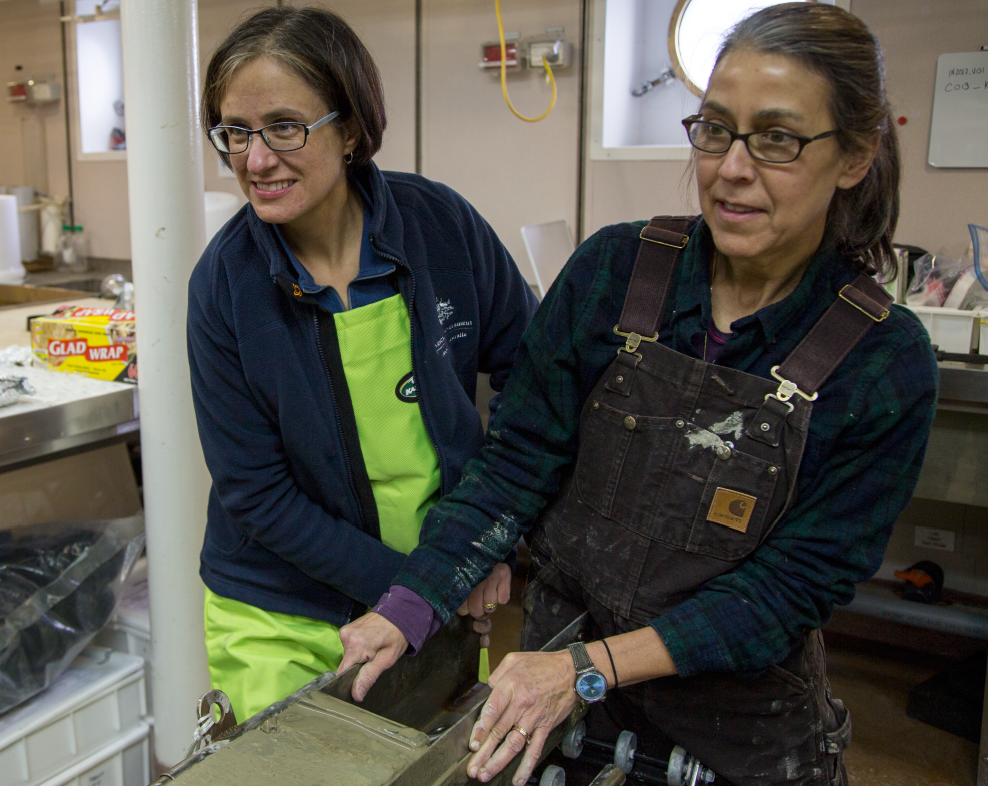
Alix (L) and Amy (R) getting the Kasten core into position to collect samples.
Amy’s life work has revolved around studying paleoclimate, which seeks to understand the world’s historic climate: how, why and how fast it changed, with the aim of predicting future changes. However, when Amy first started in her field almost 40 years ago, the future wasn’t such a big focus because most of the world had no idea that our climate was changing.
“For me, the world’s past climate was like a giant puzzle and I felt like even if I just did a little piece, I was contributing to a bigger puzzle,” Amy said.
“This was before ‘global warming’ was even a phrase, before we knew there was a really big problem to address.”
Like Leanne, her work focuses on diatoms –marine microalgae that help produce oxygen.
“Diatoms answer questions about the climate because they are sensitive to environmental changes. Their presence or absence can tell us about past temperatures, how much sunlight was available, and where the sea ice in Antarctica extended to – all important pieces of the climate puzzle.
“When I look at diatoms through a microscope, it’s like reading a book but in a different language. I’ve spent my whole life trying to understand their language,” Amy said.
Antarctica is Amy’s favourite place. She completed her first trip at just 24 and has been back more than 20 times.
“I just love Antarctica. It’s quiet with beautiful, endless skies and really unique colours. I’ve often worked in really remote and isolated settings where you’re the first person to be there. It’s a really special feeling.”
Dr Tara Martin, Oceans and Atmosphere, CSIRO

Tara running the instrumentation on board Investigator
Tara running the instrumentation on board Investigator.
Tara has been a marine geophysicist for close to 20 years and has spent two of those years at sea.
“Over the years a lot has changed on ships. It was sometimes very blokey and it wasn’t unusual for me to be the only female on board. As more women have become involved in marine science, the environment has changed and I think men appreciate that change as well,” Tara said.
Tara’s work on Investigator involves running the high-tech instrumentation on the ship including the sonar equipment and the gravity meter, which as the name suggests, measures gravity.
“Using the instrumentation on the ship, we can see what’s happening in the water column, at and below the sea floor and what the earth’s crust under the sea floor is made of. On the recent Investigator voyage, this instrumentation helped Leanne decide the best place to take samples of the sea floor.”
Tara’s first trip to Antarctica was 17 years ago when she joined a voyage with Leanne and Alix to study the Mertz Glacier.
“Antarctica is the purest and most pristine place on earth – it’s a giant laboratory. There’s still an awful lot we don’t understand about it,” Tara said.
After years working for the British Antarctic Survey, Tara was coaxed to Australia to be part of the team responsible for planning and developing the science infrastructure on Australia’s world-class research vessel, Investigator.
“It was a once in a life time opportunity to give something back to the research community. For years I’d benefitted from world-class research vessels, and the idea of being involved in delivering world-class infrastructure to Australian scientists was something I couldn’t pass up. “
Dr Linda Armbrecht, Macquarie University
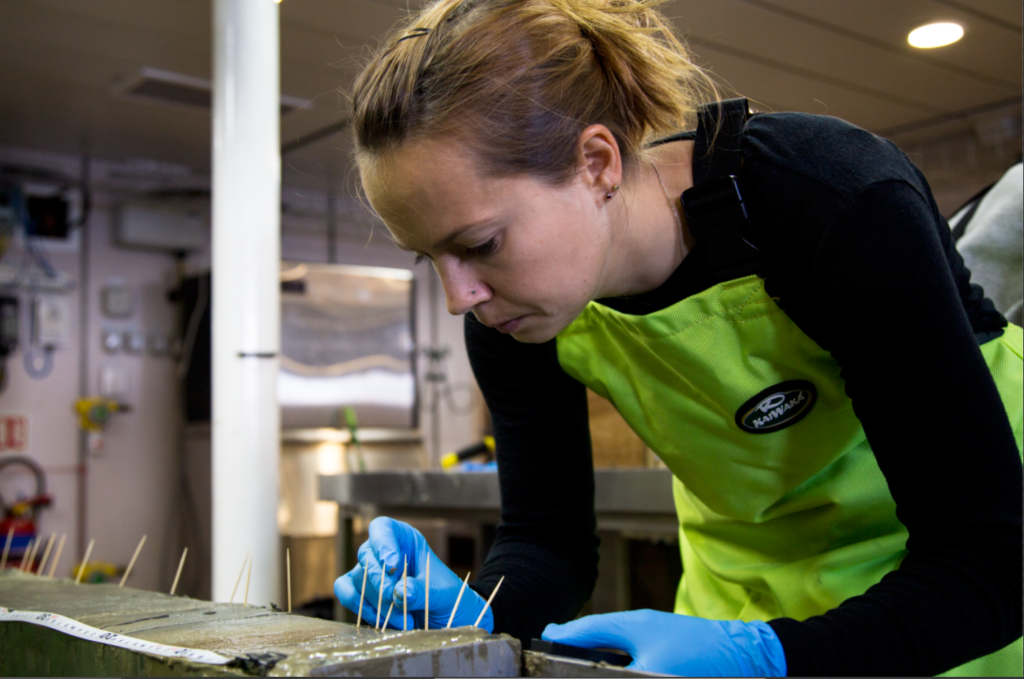
Linda taking samples of the Kasten core for her DNA work
Linda taking samples of the Kasten core for her DNA work.
Linda is a biologist from Germany and has been living in Australia for more than six years.
For a long time, she wanted to work with some of the largest animals on Earth as a wild animal veterinarian in Africa. But life led her in a different direction, to instead study some of the smallest organisms on earth – phytoplankton.
“Phytoplankton might be small but they’re really important for the world – every second breath we take is made possible by phytoplankton,” said Linda.
Linda’s research on Investigator is looking at extracting DNA from phytoplankton samples from the ancient sea floor.
“This is the first time researchers have tried to do DNA sequencing on 30,000 year old Antarctic phytoplankton fossils. I’m hoping it will tell us which types of phytoplankton thrived and which didn’t under different environmental conditions, so we know how different species might cope with continued changes to the climate.”
The recent Investigator voyage was Linda’s second time to Antarctica and her fourth voyage on a large research vessel.
“I wish I could move to Antarctica because it makes the most sense for my research. It’s just so beautiful, though I’m not sure how my partner Adam and cat Django would feel about it.”
Dr Sheri Newman, doctor on board Investigator
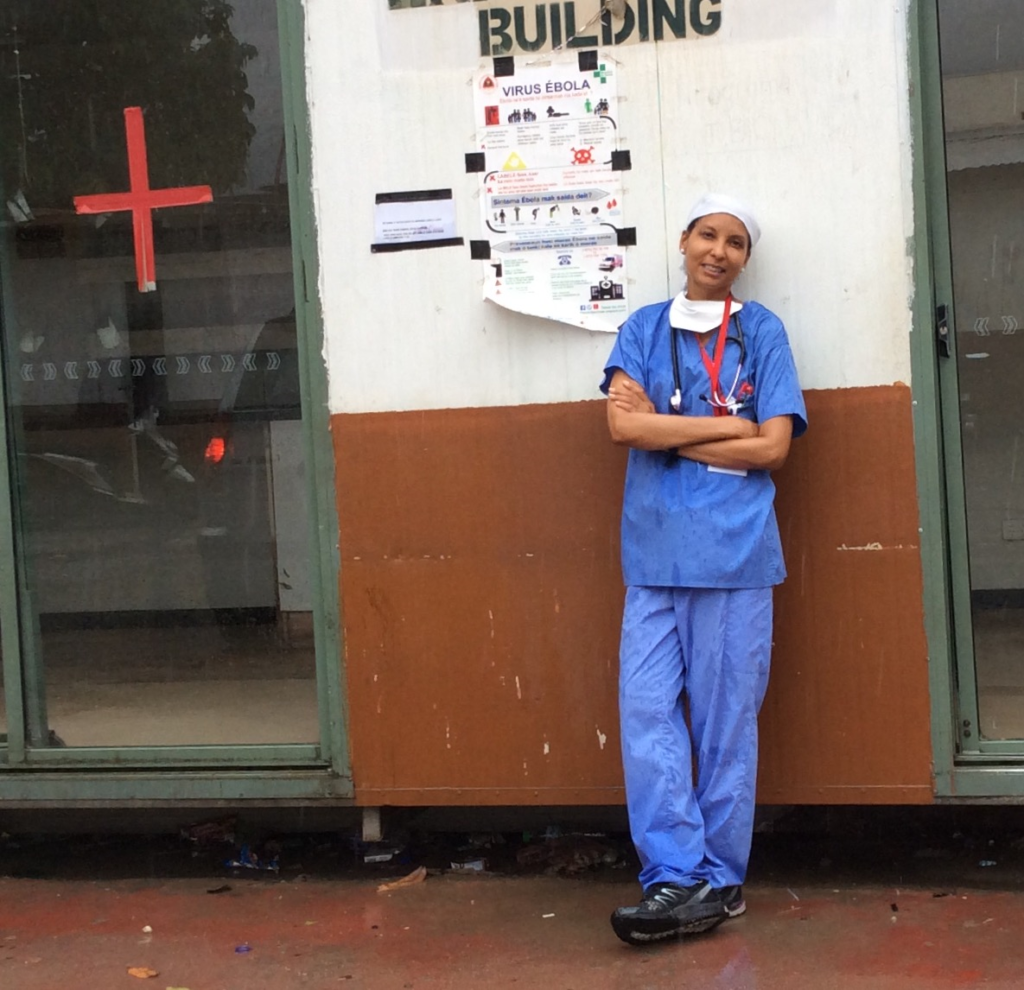
Sheri outside a community health clinic in East Timor
Sheri outside a community health clinic in East Timor.
Unlike the other doctors in this story, Sheri is the human-doctor type. She specialises in rural and remote medicine, which is just the type of doctor you want on the board when away for almost two months at sea.
Sheri has been to more than 17 countries, as both a doctor, medical student and intrepid traveller.
She’s sailed almost every ocean, spent a year in Antarctica, worked in a TB clinic in India, helped people with high altitude sickness at Everest Base Camp, cared for women in Peru at a women’s health clinic, worked as a community doctor in East Timor and even learned marine science as a diver on a research project in East Africa.
“My favourite part of rural and remote medicine is the challenge of doing something different every day, knowing you’re skilled enough to manage anything from tropical medicine to general surgery. In some jobs, I have even set up and run my own hospital,” said Sheri.
Working in remote areas is not for the feint-hearted.
“During the Antarctic winter, there was no possibility of evacuation if someone was seriously ill. Added to this, no daylight for months, blizzard conditions, and the isolation of being away from home for a year meant my job could be daunting. But this kind of challenge draws me back to interesting jobs all the time,” said Sheri.
“On the Investigator voyage, it was fantastic to be back at sea as well as in the Antarctic environment. And it was a privilege to learn about an area of science I’d had no exposure to. That, and watching icebergs float past the hospital window.”
The Marine National Facility operates Investigator, Australia’s only blue-water research vessel dedicated to marine research throughout Australia’s vast ocean territories. The Marine National Facility is owned and operated by CSIRO for the benefit of the nation.


20th July 2019 at 8:32 pm
Hi i am not sure who will gets this but just to say Dr Sheri Newman you are a super star, you seem to have done some amazing things in life already.Your family must be very proud, lots of love still Andrew Case,yes i am still around and very well .How is Ingrid? XoXoXo Hope someone puts us in touch it would be great to talk to you again.
Pingback: International Women's Day: Be bold for STEM change
10th March 2017 at 3:40 pm
A wonderful story … so inspiring. I was lucky enough to board Investigator in dock in Hobart and interview Dr Tara Martin. She’s included in this round-up I did for #IWD … plus there’s a video of her on Investigator (which links to two more videos). Go gals! https://www.gereports.com.au/2017/03/07/be-bold-for-stem-change/
8th March 2017 at 1:31 pm
Thankyou so very much for telling us about these wonderful women. It is an inspiration for my 8 year old daughter.
8th March 2017 at 10:19 am
This is a great story, and congratulations to all the very talented women involved, some of whom I know well from my work over the years as a marine geologist. The science of this Antarctic margin is really exciting and I hope the expedition leads to some deeper drilling through the international scientific ocean drilling organisation, IODP.